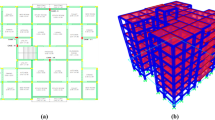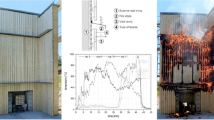Abstract
At present, research on the failure laws and depths of coal seam floors mainly concentrates on the working surface level, and there are few studies focused on the entire mining area. For this study, the No. 12 coal mine in Pingdingshan, China, was selected as the study site. Combining field tests, numerical simulations, and the vulnerability index method, the prediction of the destroyed floor depth was studied for the whole mining area. The ultrasonic detection method was used to measure the floor failure depth in two working faces, which laid the foundation for later numerical simulation. The orthogonal test results from a FLAC3D numerical simulation were analyzed using the deviation analysis method, and the weight of each factor influencing floor failure was determined. Based on the borehole exploration data of the mining area and the graphic superposition function of GIS, the vulnerability zoning model of the coal seam floor in the mining area was established. Through a comparison with the predictive values of the floor damage depth of the typical working faces, the corresponding relationship between the floor damage depth and the fragility zone was established. The following results were obtained: the six factors that affect the floor damage depth in order of weight were the working face oblique length, roof lithology combination, mining depth, floor lithology combination, coal thickness, and coal seam inclination, respectively. When the degree of the coal floor vulnerability increases by 1 level, the depth of damage increased by 5 m; the predicted values of the floor damage depth of the mining area were from 14.45 m to 30.84 m. The prediction of the floor failure depth based on the improved vulnerability index method is a new method for the study of the floor failure depth of coal seams in mining areas.











Similar content being viewed by others
References
Duan HF, Jiang ZQ, Zhu SY et al (2011) Measured analysis of deformation and failure law of mining floor in fully mechanized thin coal seam. J Mining Saf Eng 28(03):407–414
Feng MM, Mao XB, Bai HB et al (2009) Experimental study on crack evolution of coal seam floor waterproof layer in confined water mining. Chin J Rock Mech Eng 28(02):336–341
Gao WF, Han J (2020) Prediction of destroyed floor depth based on principal component analysis (PCA)-genetic algorithm (GA)-support vector regression (SVR). Geotech and Geological Engineering. https://doi.org/10.1007/s10706-020-01227-3
Gao W, Shi L, Zhai P (2019) Water detection within the working face of an underground coal mine using 3D electric resistivity tomography (ERT). Environ Eng Geol 24(3):497–505
Gao MZ, Xie J, Gao YN et al (2021) Mechanical behavior of coal under different mining rates: a case study from laboratory experiments to field testing. Int J Min Sci Technol 31:825–841
Gong PL, Hu YQ, Zhao YS et al (2005) Three dimensional similarity simulation study on deformation and failure law of floor under pressure mining. J Rock Mech Eng 23:4396–4402
Han L, Wang L, Ding XN, et al. (2022) Similarity quantification of soil parametric data and sites using confidence ellipses. Geoscience Frontiers 13: 101280
Hu YB, Li WP, Wang QQ et al (2019) Study on failure depth of coal seam floor in deep mining. Environ Earth Sci 78(24):697
Li BY (1999) ‘“Down three zone”’ for predicting water inrush from coal bed floor aquifer theory, development and application. J Shandong Min Inst 4:11–18
Li JL, Zhang HY, Wang XY et al (2014) Application and suggestion of vulnerability index method in predicting water inrush from coal floor. J China Coal Soc 39(4):725–730
Li JL, Li ZQ, Wang XY et al (2015) Grey prediction of mine discharge based on R/S analysis. J Saf Environ 15(5):5–10
Li A, Ma Q, Lian YQ et al (2020) (2020) Numerical simulation and experimental study on floor failure mechanism of typical working face in thick coal seam in Chenghe mining area of Weibei. China Environ Earth Sci 79:118
Li C, Wu Z, Zhang WL, Sun YH et al (2020b) A case study on asymmetric deformation mechanism of the reserved roadway under mining influences and its control techniques. Geomech Eng 22(5):449–460
Li XS, Peng K, Peng J, Hou D. (2021) Experimental investigation of cyclic wetting-drying effect on mechanical behavior of a medium-grained sandstone. Eng Geol 293:106335
Liang P, Gao YT, Zhou Y, Zhu C et al (2020) Solution for surrounding rock of strain-softening considering confining pressure-dependent Young’s modulus and nonlinear dilatancy. Geomech Eng 22(4):277–290
Liu WT, Liu SL, Ji BJ (2015) Sensitivity analysis of controlling factors on failure depth of floor based on orthogonal experiment. J China Coal Soc 40(9):1995–2001
Liu SQ, Wu Q, Zeng YF et al (2017a) Improved AHP vulnerability index method based on GIS. Earth Sci 42(04):625–633
Liu WT, Mu DR, Xie XX et al (2017b) Sensitivity analysis of the main factors controlling floor damage depth and a risk evaluation of floor water inrush for an inclined coal seam. Mine Water Environ 37(3):636–648
Liu WT, Mu DR, Li Y et al (2017c) Calculation method and main factor sensitivity analysis of inclined coal floor damage depth. J China Coal Soc 42(4):849–859
Liu YB, Yang HZ, Liu C (2020) Study on the influence of coal face advancing distance on fault-activated water inrush. Geotech Geol Eng. https://doi.org/10.1007/s10706-020-01234-4
Meng XX, Liu WT, Zhao JY et al. (2019) In situ investigation and numerical simulation of the failure depth of an inclined coal seam floor: a case study. Mine Water Environ 38(3)
Qian MG, Miao XX, Li LJ (1995) Mechanism for the fracture behaviors of main floor in longwall mining. Geotech Geol Eng 6:55–62
Shi LQ, Han J (2004) Mechanism and prediction for waterinrush from coal seam floor. China University of Mining and Technology Press, Xuzhou, China
Wang ZY, Liu HQ (1993) Mining above confined aquifers. Mining Industry Press, Beijing, China
Wu Q (2014) Progress, problems and prospects of prevention and control technology of mine water and reutilization in China. J China Coal Soc 39(5):795–805
Wu Q, Wang MY, Wu X (2004) Investigations of groundwater bursting into coal mine seam floors from fault zones. Int J Rock Mech Ming Sci 41(4):557–571
Wu Q, Pang W, Dai YC et al (2006) GIS and ANN coupling technology for vulnerability assessment of coal mine floor water inrush. J China Coal Soc 31(3):314–319
Wu Q, Yang L, Zhu B, Li JM et al (2009) Application of “vulnerability index method” in evaluation of water inrush from floor of Zhaogezhuang Mine. Coal Geol China 21(06):40–44
Yin HY, Liliana L, Wei JC et al (2016) A multi-method approach for estimating the failure depth of coal seam floor in a longwall coal mine in China. Geotech Geol Eng 34(5):1267–1281
Yu XG, Han J, Shi LQ et al (2017) Application of a BP neural network in predicting destroyed floor depth caused by underground pressure. Environ Earth Sci 76:535
Zhang JC (2005) Investigations of water inrushes from aquifers under coal seams. Int J Rock Mech Min Sci 42:350–360
Zhang PQ (2015) Failure depth detection of disturbed floor based on ultrasonic technology in coal mining. Coal Science and Technology 43(05):118–121
Zhang FD (2016) Study on deformation and failure mechanism and water inrush evaluation method of deep coal seam floor. China University of Mining and Technology, Beijing
Zhang J, Shen B (2004) Coal mining under aquifers in China: a case study. Int J Rock Mech Min Sci 41(4):629–639
Zhang JC, Zhang YZ, Liu TQ (1997) Rock mass seepage and water inrush of coal seam floor. Geological Publishing House, Beijing, China
Zhang R, Jiang ZQ, Li XH et al (2013) Study on the failure depth of thick seam floor in deep mining. J China Coal Soc 38(1):67–72
Zhang WQ, Zhao K, Zhang GB et al (2015) Failure depth prediction of floor based on grey correlation analysis theory. J China Coal Soc 40(S1):53–59
Zhang JG, Wang Q, Guo JW, et al. (2020) Prevention and comprehensive utilization of Cambrian limestone groundwater disaster in Pingdingshan coalfield. Emergency management press, Bejing, China. ISBN: 978-7-5020-7455-6
Zhu SY, Cao DT, Zhou HY et al (2014) Restrictive function of lithology and its composite structure on deformation and failure depth of mining coal seam floor. J Mining Saf Eng 31(1):90–96
Funding
This study was financially supported by the Key Scientific Research Projects of Colleges and Universities in Henan Province in 2022 (22A170009) and the Natural Science Foundation of China (41972254).
Author information
Authors and Affiliations
Corresponding author
Ethics declarations
Consent for publication
The manuscript is approved by all authors for publication.
Conflict of interest
The authors declare no competing interests.
Additional information
Responsible Editor: Murat Karakus
Rights and permissions
About this article
Cite this article
Li, J., Zhang, M., Wang, X. et al. Prediction of destroyed coal floor depth based on improved vulnerability index method. Arab J Geosci 15, 192 (2022). https://doi.org/10.1007/s12517-022-09481-w
Received:
Accepted:
Published:
DOI: https://doi.org/10.1007/s12517-022-09481-w




